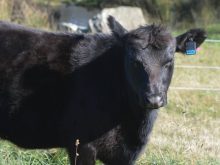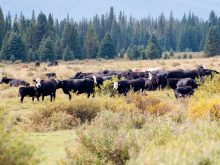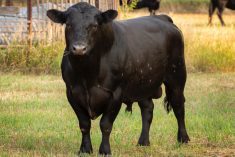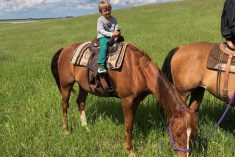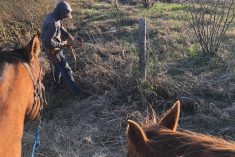In 1991, three years after they purchased their first four registered Texas Longhorn heifers, Deb Lesyk and Dwight Overlid were in the show ring at the Canadian Western Agribition, in Regina.
In 2001, a bull they had raised and dubbed Nebuchadnezzar, or Nezzar for short, won the Canadian circuit championship. Next, they showed Nezzar in Billings, Montana where he won Grand Champion Bull after which he went on to Nebraska the following spring where he again was chosen Junior Champion Bull as a yearling.
“A breeder from Texas purchased Nezzar in 2002,” says Overlid. “And he went on to win the World Championship two years in a row — first as Junior Bull and then overall World Champion Senior Bull. We were pretty tickled.”
“He was just a big gentle animal with personality and all the right characteristics and conformation,” says Lesyk. “He was the first Canadian Longhorn bull to win the TLBAA (Texas Longhorn Breeders Association of America) World Championship in Texas. We continue to see his offspring winning top prizes. He left his legacy.”
By now Lesyk and Overlid, who own Double “D” Arena near Outlook, Sask., had fallen in love with this historic breed of cattle and were excited to continue producing genetic stock on their acreage.

Very versatile and adaptable breed
In 2004, however, BSE closed the U.S. borders to Canadian cattle and Lesyk and Overlid had to tuck in the wings on some of their plans. They continued their breeding program but on a smaller scale, instead promoting what they knew Longhorns are noted for — their hardiness, longevity, disease resistance, fertility, reproductive efficiency, marketability and their excellent-quality meat.
Longhorns are hardy animals and adapt to hot or cold climates. They require minimum maintenance. “We have limited acres here, and it’s sandy land with bush,” says Lesyk. “So we needed an animal that could survive on marginal land. Longhorns are browsers, and even during dry years, they do well. They will graze and forage plants and shrubs that other breeds leave untouched.”
Read Also

Harvest wraps up and fall work begins
At the Eppich famly ranch in western Saskatchewan, the fall harvest was successful with few breakdowns, cows and calves have been sorted and a new tractor has arrived
Texas Longhorns are noted for their longevity and will continue to produce calves into their 20s. Females are excellent mothers and have a tight, well-proportioned udder. Bulls are known for their libido, high fertility rates, and will breed well into their teens. Ease of calving is another benefit of the Longhorns. Producing calves with a slightly lower birth weight, makes the Longhorns ideal for crossbreeding to first-time heifers. The calves are vigorous and quick to gain weight.
Longhorns are known for their strong immune systems and are better able to resist diseases such as pinkeye and foot rot. “We don’t go overboard on injections,” says Lesyk, noting they follow a basic animal health protocol. “The babies get selenium and vitamins D and E when they’re born. Mature cattle are treated with Ivomec and they get their seven-way shots and that’s it.” Some breeders are opposed to any injections claiming the vaccines will hinder the breed’s natural immunities and resistances.
The breed’s docile nature is another advantage. Overlid’s grandson Derek has worked with the Longhorns since he was about nine years old. “When I was younger, I’d saddle up a horse and go out there by myself to bring the cows in,” says Overlid. The cows are gentle, intelligent and easy to work with. “Yes, there are some that have an attitude,” says Lesyk. “We won’t keep anything that doesn’t behave itself.”

Lesyk says the herd “meeting ritual” that occurs when a new calf is born is fascinating to watch, citing a recent example. “When the calf was up and going, mother and baby came in for water,” she says. “The whole herd started moving toward the pair. Gradually they all introduced themselves, beginning with the yearlings, then the two-year-olds, and so on including the old matrons. It was like they all had to give their approval. Then the calves came bouncing over as if to welcome the new calf. It’s a beautiful ceremony.
“During the day, you’ll often see the yearlings and the two-year-olds babysitting while the mothers come in to drink. It’s as if they are teaching the younger ones all about motherhood.”
Good, diverse marketability
Marketability also makes Longhorns desirable for both new and established breeders. “We raise for genetic stock but there’s also a ready market for recreational stock, such as ropers,” says Overlid. “The nostalgia and history of the breed is attractive to both hobbyists and weekend ranchers who are looking for a few animals for their acreage.”
The demand for lean beef from individual health-conscious consumers as well as restaurant owners is on the rise. Longhorn beef is low in cholesterol and saturated fat. For anyone looking for healthy food choices, lean beef is the No. 1 source of protein, zinc and Vitamin B12, and the third best source of iron in the food supply. Beef is also a good source of selenium, an important nutrient that may reduce the risk of heart disease and certain types of cancer.
Back to the show ring
In 2012 Lesyk and Overlid stepped back into the show ring and they continue to win. They today have 12 registered cows, all of which have been show champions and have produced class winners.
The Longhorn industry draws two main interests — people who raise them for the beef, and those who breed them purely for their horns. “We breed for conformation and genetics,” says Lesyk. “We’re trying to keep the beef on them. If we also get the 70- to 80-inch long horns, that’s a bonus. But at the end of the day, the animal has to stand in the show ring and be judged on how it looks, not just for its set of horns. It can’t end at the head.”
Lesyk and Overlid have judged at shows in the U.S, and more recently in Australia. They will continue to show and promote the Texas Longhorn breed. “The interest is out there,” says Overlid. “People are beginning to understand the usefulness of this breed. Although most commercial cattlemen might not admit it, many have used Longhorn bulls on their first-calf heifers. The unusual colour patterns, the different types of horns and just the uniqueness of the breed makes it a front-pasture purchase that’s fun to raise. The skulls, the hides, the calves for recreational purposes and the lean delicious meat keeps our phone ringing with inquiries. They are easy and interesting animals for people to raise.”
Lesyk has served as a director of the Canadian Texas Longhorn Association as well as the Alberta Texas Longhorn Association. She was on the board of the TLBAA in Ft. Worth, Texas and is currently involved in the National Affiliate Committee of the TLBAA. She continues to work full-time as the director of care at St. Ann’s Senior Citizen Village in Saskatoon. Overlid worked with the irrigation district in the Outlook area until his retirement in 2001. His interest in Texas Longhorns goes back to when he watched these majestic animals in pastures in his irrigation area. “I always wanted to own one,” he says.
For more information, contact the Double “D” Arena at 306-867-9427 or email [email protected]. Various Longhorn websites include: Texas Longhorn Breeders Association of America; Canadian Texas Longhorn Association; Alberta Texas Longhorn Association or International Texas Longhorn Association.




